SECTION 1-A 1957 BUICK LUBRICARE INSTRUCTIONS
1-1 EVERY 1000 MILES – 1957 BUICK LUBRICARE
1957 Buick Lubricare – Chassis
- Check engine oil level only after engine has been stopped for at least three to five minutes to allow oil to drain down.
The oil level should be maintained between the “FULL” and “ADD 1 QT” marks on gauge rod; the space between marks represents 1 quart. It is best to maintain the oil level within one quart of the “FULL” mark. Do not fill above the “FULL” mark. See figure 1-2.
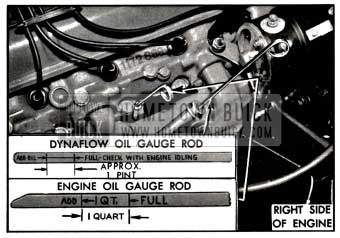
1957 Buick Engine and Dynaflow Oil Gauge Rods
See paragraph 1-5 for engine oil recommendations and when to change oil.
- Front suspension, Brake, Clutch and Transmission Controls. Wipe dirt from lubrication fittings, then apply a good grade of water resistant chassis lubricant, under pressure, at the following points (fig. 1-1):
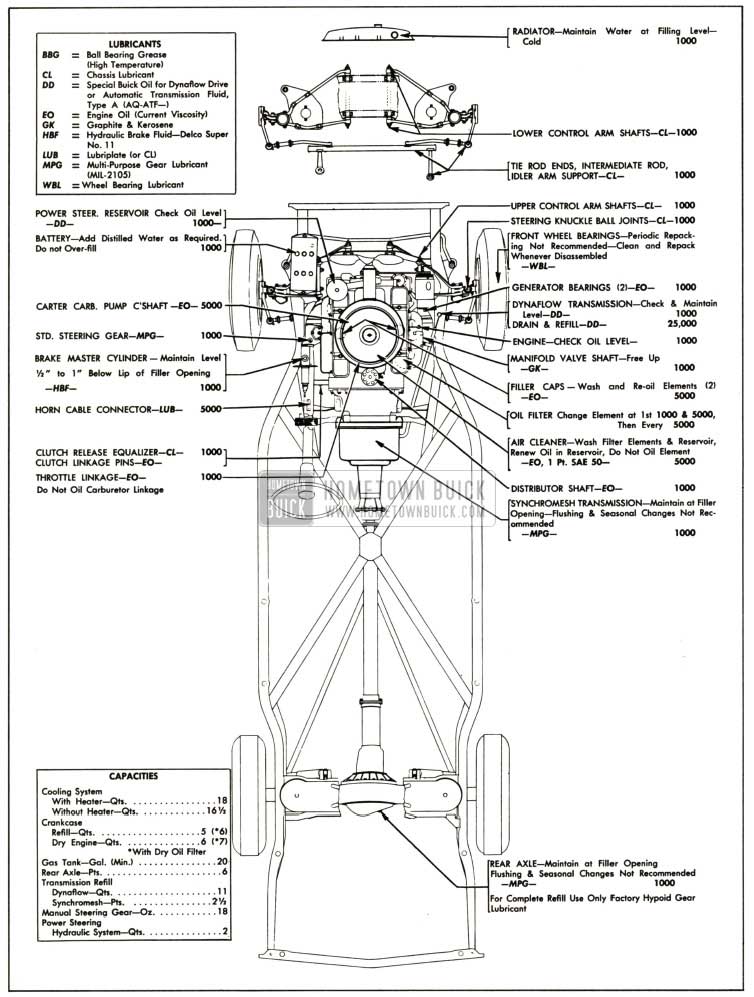
1957 Buick Chassis Lubricare Chart
- Lower Control Arms, inner ends
- Upper and Lower Ball Joints
- Tie Rod Ends, Intermediate Rod, and Idler
- Arm Support Bushing.
- Clutch Release Equalizer
- Clutch Pedal Linkage Pins, lubricate with engine oil.
- Oil Filter. Change original oil filter element at first 1000 miles. See instructions in paragraph 1-2.
- Synchromesh Transmission. Check oil level, after allowing time for oil to settle. Clean the surrounding area before removing filler plug. Level should be maintained at filler plug opening by adding Multi-Purpose Gear Lubricant (MIL-2105). Use SAE 90 for temperatures not lower than 10°F. below zero; for temperatures continuously lower than -10°F use SAE 80. NOTE: Draining and flushing transmission is not necessary at any time unless the lubricant has become contaminated.
- Rear Axle. Check oil level, after allowing time for oil to settle. Clean the surrounding area before removing filler plug. Level should be maintained at filler plug opening by adding SAE 90 Multi-Purpose Gear Lubricant (MIL-2105). When car is operated in temperatures continuously below -10°F., use SAE 80 Multi-Purpose Gear Lubricant. NOTE: Draining and flushing is not necessary at any time unless the lubricant has been removed to perform repairs. When complete refilling is required use only Factory Hypoid Lubricant as specified in paragraph 1-6.
- Dynaflow Transmission. Check transmission oil level, with transmission oil warm, transmission in Parking, and engine idling. Remove gauge rod located under right side of hood (fig. 1-3), wipe dry with clean cloth then reinstall to full depth. Remove rod and note oil level.
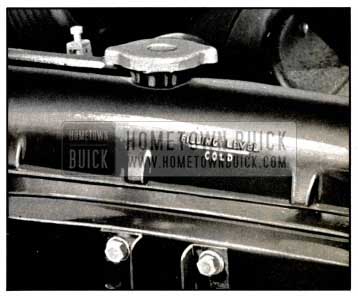
1957 Buick Radiator Filling Level-Cold
If oil level is more than one inch below the “FULL” mark on gauge rod, add oil specified in paragraph 1-3 but do not fill above the “FULL” mark. Distance between the “FULL” and “ADD OIL” mark is one inch and represents approximately one pint.
- Fill oil cup with SAE 10W engine oil.
- Air Cleaner. Normally serviced every 5000 miles. If car is operating in dusty territory, however, check condition of air cleaner and clean it if dirty. See instructions in paragraph 1-2.
- Generator; Fan Belt. Fill front and rear oilers to the caps with light engine oil. Wipe off excess or spilled oil. Never lubricate the commutator and do not lubricate generator while it is operating.
If oil reserve in commutator end bearing is exhausted due to failure to lubricate at proper intervals, the rear oil cup should be filled 3 times, allowing time for each filling to soak down.
Inspect fan belt for cracks and for proper tension. See figure 2-37.
- Check coolant level when engine is cold and add water to line marked “Filling Level-Cold” stamped on head tank. See figure 1-3. CAUTION: Radiator cap should not be removed when engine is hot because relieving the pressure may cause the cooling system to boil, with resultant loss of water or antifreeze solution. Filling radiator when hot, or filling above level line may result in loss of water or anti-freeze solution through overflow pipe.
- Add distilled water to bring level to split ring at bottom of filler well. See figure 1-4. WARNING: Do not overfill. Clean top of battery; if wet with acid, neutralize with soda and wash clean.
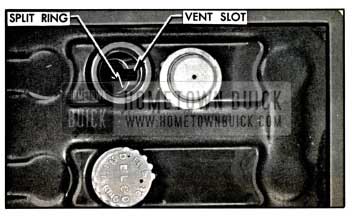
1957 Buick Battery Filler Well Lubrication
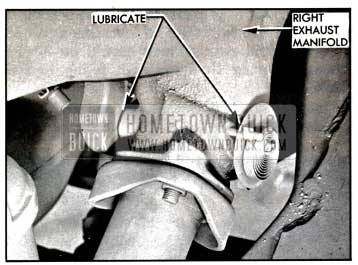
1957 Buick Manifold Valve
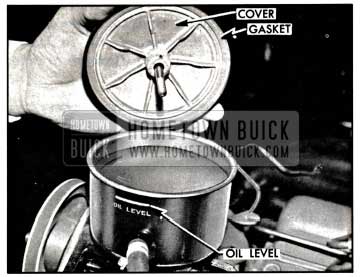
1957 Buick Oil Pump Reservoir
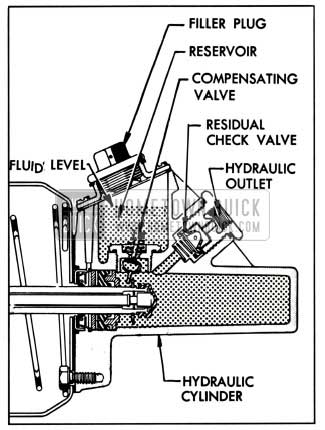
1957 Buick Bendix Power Brake Reservoir
Thoroughly clean filler cap nut before removal to avoid getting dirt into reservoir. Add fluid as required to bring level to 1/2″ to 1″ below top of filler opening. Use G.M. or Delco Super No. 11 Hydraulic Brake Fluid. Never use reclaimed fluid or any mineral oil. On Bendix Power Brake units bring fluid level to within 1/4″ of threads on low side of filler opening.
- Inflate all tires according to- tire temperatures, as follows:
- 24 lbs. Starting Pressure-after car has been standing for 3 hours or driven less than one mile.
- 26 lbs. City Pressure-after car has been driven 3 miles or more BELOW 40 MPH.
- 28 lbs. Highway Pressure-after car has been driven 3 miles ABOVE 40 MPH.
WARNING: It is impossible to inflate tires correctly when HOT. Pressure normally increases as tires heat up when driving. Do not deflate tires to offset this increase in pressure.
1957 BUICK LUBRICATION CHART
1957 Buick Lubricare – Body
- Hood Latch and Hinges. Lightly coat hood latch, lever, and dovetail bolt with Lubriplate. Apply engine oil to hood hinge pins.
- Door locks and Strikers. Remove dirt and old lubricant from door locks and strikers. Apply one or two drops of SAE 10 engine oil to lock roller pins, and apply a light coat of G.M. Door-Ease Lubricant to top surface of lock roller housings and to teeth in strikers. Wipe off excessive lubricant. See figure 1-8.
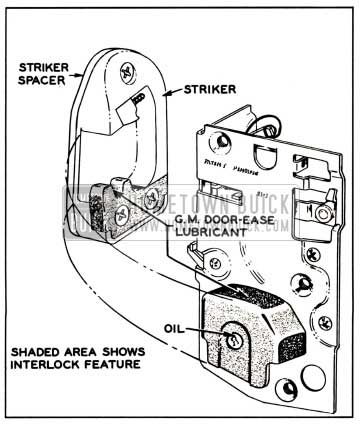
1957 Buick Door Lock and Striker
1-2 EVERY 5000 MILES – 1957 BUICK LUBRICARE
- Oil Filter. Change original filter at first 1000 miles, the second element at first 5000 miles, then change element at each 5000 mile interval thereafter.
Loosen the container bolt and allow oil to drain out. Remove container, element, old gasket. See figure l-9.
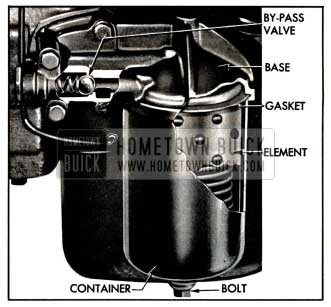
1957 Buick Oil Filter
Wash and dry container and make sure that gasket surfaces are clean. Install new type G-270 gasket in undercut in filter base; then install new AC Type PF-122 element and old container, tightening bolt securely. Check for oil leaks after engine has run for 5 minutes.
- Air Cleaner and Oil Filler Caps. Every 5000 miles (more often under dusty operating conditions) remove the air cleaner element and the oil filler caps and wash the filtering elements in a non-inflammable solvent. DO NOT USE KEROSENE. Allow elements to drain until dry. Do not use air blast on filtering element. Oil the filler cap elements.
Wash and dry the air cleaner reservoir then fill to point marked “OIL LEVEL,” using one pint of SAE 50 engine oil. See figure 1-10. Do not oil the cleaner element because oil will drain down into reservoir and over-fill it.
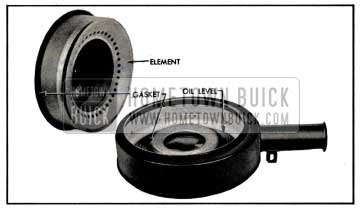
1957 Buick Air Cleaner Element and Reservoir-Series 40
Make sure that gasket at center of cleaner element is in good condition before parts are installed. Wipe all oil from outer surface of air cleaner and filler caps.
- Pump Operating Countershaft -Carter Carburetor Only. On 2-barrel carburetors, remove dust cover and apply oil in two oil holes above countershaft. See figure 1-11.
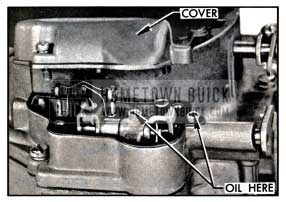
1957 Buick Countershaft Lubrication-Carter
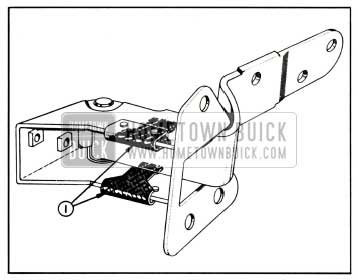
1957 Buick Door Hinge Hold-Open Springs
Apply lubriplate solution (*) to rear door lower hinges at pivot points indicated by arrows in figure 1-13.
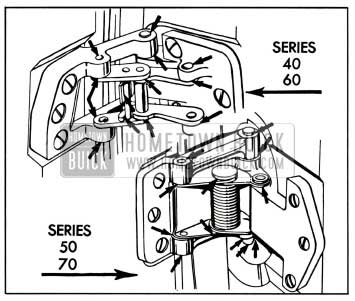
1957 Buick Rear Door Lower Hinge
*Prepare Lubriplate solution by dissolving pound of No. 630 AA Lubriplate in one pint of mineral spirits.
1-3 EVERY 25,000 MILES – 1957 BUICK LUBRICARE – DYNAFLOW TRANSMISSION
At 25,000 mile intervals the transmission should be completely drained, the oil pan and screen should be removed and cleaned, and the transmission should be refilled with fresh oil. Transmission MUST NOT BE FLUSHED when oil is changed.
Approved Oils for Dynaflow Transmission
The following oils are approved for Dynaflow Drive and no other fluid should be used.
- Special Buick Oil for Dynaflow Drive, available through Buick Parts Warehouses under Group 4.101.
- Automatic Transmission Fluid, Type A, available through petroleum suppliers. This fluid must have an AQ-ATF number embossed in lid of the can for identification.
Draining and Refilling Dynaflow Transmission
- Warm up transmission, then remove bell housing cover.
- Loosen one converter drain plug, through opening in flywheel, then turn flywheel until opposite drain plug is straight down and remove this plug to allow converter to drain completely. See figure 1-14.
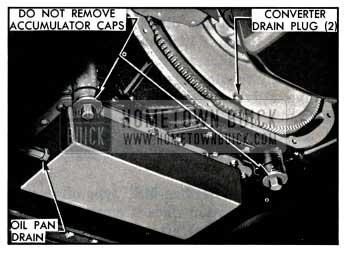
1957 Buick Dynaflow Transmission Drain Plugs
A transmission refill requires approximately 11 quarts total. A completely dry transmission requires an additional 1 3/4 pints.
1-4 1957 BUICK LUBRICARE – AS REQUIRED
1957 Buick Clutch Internal Lubricare
Lubrication of internal working parts of the clutch is usually required only at time clutch is assembled and installed; however, if lubrication becomes necessary to eliminate squeaks or correct excessive pedal pressure, follow instructions given in paragraph 4-4.
1957 Buick Brake Lubricare
Lubrication of all metal contact points at wheel brake assemblies is normally performed during the major brake adjustment or may be performed whenever a brake drum is removed.
Lubrication of parking brake cables is also performed during the major brake adjustment; however, operation under conditions where mud and water are frequently encountered may require more frequent lubrication. See paragraph 9-9.
1957 Buick Rear Wheel Bearing Lubricare
Rear wheel bearings are lubricated by gear lube splash from the differential housing and need no other lubrication. Whenever rear brakes are relined, or axle shafts are removed for other work, it is advisable to inspect rear wheel bearings and oil seals. Replace seals if leaking or worn.
1957 Buick Speedometer Cable Lubricare
The speedometer cable is factory lubricated with special all-season grease and normally requires no further service unless it becomes noisy. In extremely hot climates or where considerable dirt and water are encountered, however, it may be necessary to lubricate the cable at intervals of approximately 20,000 miles or every two years. See paragraph 10-58.
1957 Buick Sunshade Lubricare
If the sunshade rod turns hard in the support as sunshade is moved up and down, remove retainer screw, pull rod from support and apply G. M. Door-Ease Lubricant. Do not use oil, which may soil body trim. Install rod in support and adjust retainer screw to proper tension.
Roof Side Rail Sealing Strip
The mechanical (“flipper”) type sealing strips mounted on the roof side rails above the doors on some models should be lubricated occasionally to insure proper operation and minimum wear.
- Open the door and apply a coat of Lubriplate No. 107 or No. 110 to entire length of hinge indicated in figure 1-15. Wipe off any excess. Do not apply this lubricant to the awning gasket.
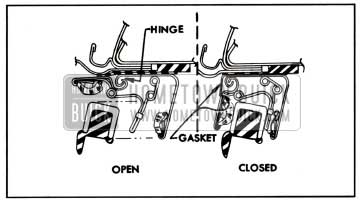
1957 Buick Sealing Strip Lubricare
1-5 1957 BUICK ENGINE OIL RECOMMENDATIONS
Choice of 1957 Buick Engine Oil
- Brand of Oil. In the selection of the proper brand of oil it is essential to consider the reputation of the refiner or marketer. It is imperative that the same brand of oil be used at all times.
- Type of Oil. There are several types of oil manufactured for use in internal combustion engines. For use in the Buick engine we recommend that a heavy duty type oil marked “For Service MS” or “For Service DG” be used for maximum protection under all driving conditions. Oils marked “For Service MM” or “For Service ML” are not recommended for any Buick engine.
- Grade or Viscosity. The grade or viscosity (SAE number) of engine oil should be selected for the lowest anticipated temperature at which cold engine starting will be required as recommended in the temperature-viscosity chart below.
- Break-in Oils. Break-in oils or compounds are not necessary in Buick engines and their use is not recommended. Some of these break-in oils contain certain materials which may be harmful. Buick HD Concentrate (subpar. d) is not a break-in oil.

1957 Buick Temperature-Viscosity Chart
When to Change 1957 Buick Engine Oil
The crankcase should be completely drained and refilled with new oil of proper viscosity at the end of the first 1,000 miles and every 2,000 to 3,000 miles thereafter. Adverse driving conditions may require more frequent draining and refilling. Adverse driving conditions are those which may cause early contamination of engine oil, such as operation under unusual dust conditions or short runs with a cold engine in very cold weather.
The color of “Service MS” type oil does not indicate its condition since it normally becomes dark (black or gray) after only a few hundred miles of driving. This is because the detergent content envelopes and holds in suspension extremely fine but harmless soot (soft carbon) and lead particles. The oil filter element does not remove this harmless material but it does remove all harmful particles such as road dust, metal chips and hard carbon.
Engine crankcase oils have a definite effect on ease of starting, oil economy, combustion chamber deposits and engine wear. Many commercial crankcase oils contain heavy nonvolatile deposits forming components which make the type of combustion chamber deposits that greatly increase detonation and particularly pre-ignition, even though these oils may be designated “For Service MS” or “For Service DG.” Some commercial crankcase oils are deficient in anti-wear characteristics and may contribute to rapid wear of camshafts, valve lifter assemblies and other highly stressed engine parts. Owners should be urged to use only crankcase oils that have been proven to produce ease of starting, satisfactory oil economy, minimum combustion chamber deposits and adequate protection against wear.
1957 Buick Crankcase Flushing
Flushing the crankcase with oils or solutions other than a good grade of 10-W engine oil is not recommended. When flushing to remove contamination appears advisable, use 3 quarts 10-W oil (4 quarts if filter is drained) and idle the engine at 1000 RPM (equivalent to 20 MPH) until the oil is hot, then drain crankcase and oil filter immediately after stopping engine. Fill crankcase with correct quantity and seasonal grade of oil.
Use of Buick HD Concentrate
Buick HD Concentrate, available through Buick Parts Department under Group 1.8’50 is a compound of the materials used by oil refiners to manufacture high detergency motor oils. It is intended for use in engines operating under aggravated conditions where engine deposits, rust and corrosion cannot be adequately retarded by motor oils readily available to the average motorist. It is especially recommended for engines operated under restricted conditions such as frequent stops, short trips and slow speeds where such symptoms as sticking valves, valve lifters and rings are noticed.
Although HD Concentrate may be used continually it is normally unnecessary to use it with every crankcase refill. When used, the instructions on the container should be carefully observed.
1-6 1957 BUICK REAR AXLE LUBRICANT RECOMMENDATIONS
Lubricant Recommendations
1957 Buick rear axles are filled at the factory with a special hypoid gear lubricant. It is not necessary to remove the original lubricant at any time except when it has become contaminated, or when it is required for inspection of parts or for repairs. Therefore there is no longer a drain hole in the rear axle housing.
Under no circumstances should the factory lubricant be removed from the rear axle to be replaced with any other type of lubricant.
In all cases of complete refilling of rear axle only Factory Hypoid Gear Lubricant is recommended. This is the same lubricant (lead soapactive sulphur type) as furnished with Buick replacement ring and pinion gear sets, and it may be obtained from any Buick Parts Warehouse under Group 5.535.
When adding lubricant to bring it to proper level Factory Hypoid Gear Lubricant is preferred; however, SAE 90 Multi-Purpose Gear Lubricant (MIL-2105) may be used.
In temperatures consistently below -10° F use SAE 80 Multi-purpose gear lubricant.

Leave A Comment
You must be logged in to post a comment.